NHS Scotland - climate emergency and sustainability: annual report 2021 to 2022
Report for 2021 to 2022 providing information on; greenhouse gas emissions arising from the operations of NHS Scotland, actions which have been taken or are underway to reduce NHS Scotland’s greenhouse gas emissions and environmental impact, and actions to adapt to climate change.
4. Sustainable Care
Staff must be at the heart of work to achieve a culture of stewardship within NHS Scotland, where resources are safeguarded and responsibly used to provide environmentally sustainable healthcare. Improving patient care is fundamental and all steps taken are with the dual focus of improving outcomes for patients and reducing environmental impact. There are three national priority areas for making care more sustainable; surgery (through the National Green Theatre Programme), anaesthesia and respiratory medicine.
4.1 Medical gases
The gases that are used for anaesthetics and pain relief are potent greenhouse gases. These are nitrous oxide (laughing gas), Entonox (which contains nitrous oxide) and the “volatile gases” - desflurane, sevoflurane and isoflurane. For example; desflurane, isoflurane and sevoflurane have global warming potentials that are respectively 2540, 510 and 130 times more potent than carbon dioxide.
Throughout 2021/22, efforts to reduce these emissions continued to be made through various anaesthetic environmental networks, including Green Anaesthesia Scotland. The Centre for Sustainable Delivery, which is part of NHS Golden Jubilee, has set up the National Green Theatre Programme (NGTP), which is now supporting Health Boards with lowering emissions from anaesthetic gases.
Key Achievement - Scotland to remove highly polluting anaesthetic gas.
Desflurane, was responsible for most of the emissions from NHS Scotland’s use of volatile medical gases (desflurane, sevoflurane and isoflurane).
Green Anaesthesia Scotland, a grassroots group of anaesthetists, started to decrease the use of this drug in 2017, substituting it with another agent, sevoflurane, which is just as safe and effective, reduces carbon emissions by more than 80%, and costs four times less.
This work continued with the establishment of the National Green Theatre Programme and, after consultation with the wider anaesthetic community, it was agreed that desflurane will no longer be available on the National Procurement contract.
Figure 4 below outlines the emissions from the medical gases used in NHS Scotland from 2018/19 to 2021/22. Further data is set out in the Annex.
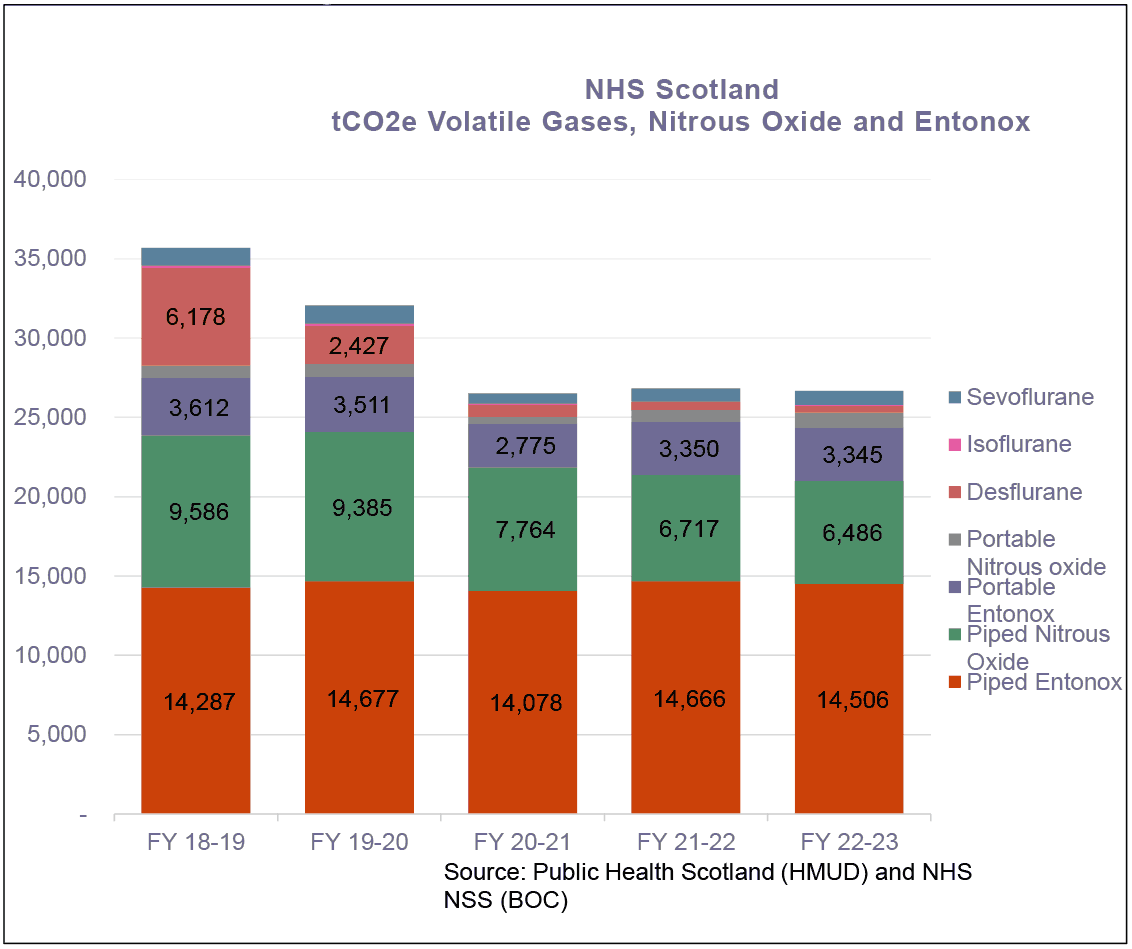 FY 2021/22. Reduction in piped nitrous oxide, desflurane and portoable entonox. Substantial reduction in Desflurane.">
FY 2021/22. Reduction in piped nitrous oxide, desflurane and portoable entonox. Substantial reduction in Desflurane.">
An 82% reduction in volatile gas emissions was achieved over the period 2018/19 to 2021/22 by:
- anaesthetists switching from desflurane in preference for sevoflurane, which has a lower environmental impact.
- using low flow anaesthetic techniques coupled with closed circuit anaesthetic machines, with end tidal control continued to reduce the total volatile consumed through system efficiencies.
- initiating a gas anaesthetic within theatre, as opposed to the anaesthetic room to encourage efficiencies.
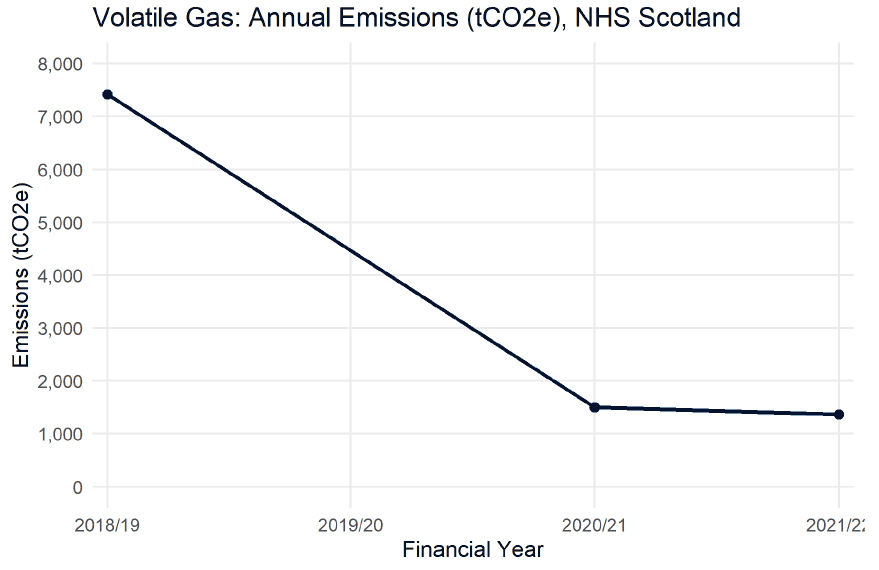
There has been a very large decrease in the use of desflurane across NHS Scotland. In February 2023, NHS Scotland National Procurement removed desflurane from the national contract. This was following a consultation period with Health Boards. This means that whilst Health Boards will still be able to purchase desflurane themselves, neither desflurane nor the necessary supporting infrastructure, will be available to buy on a national basis.
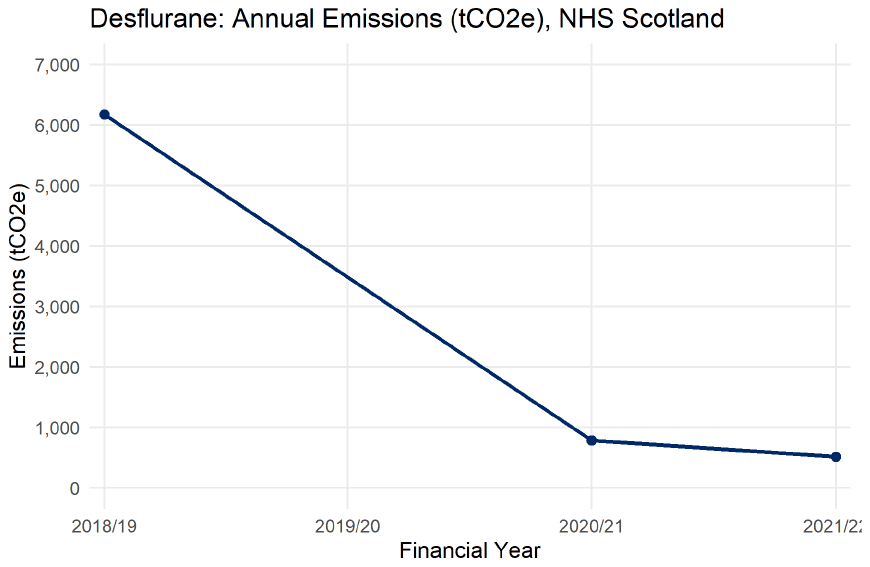
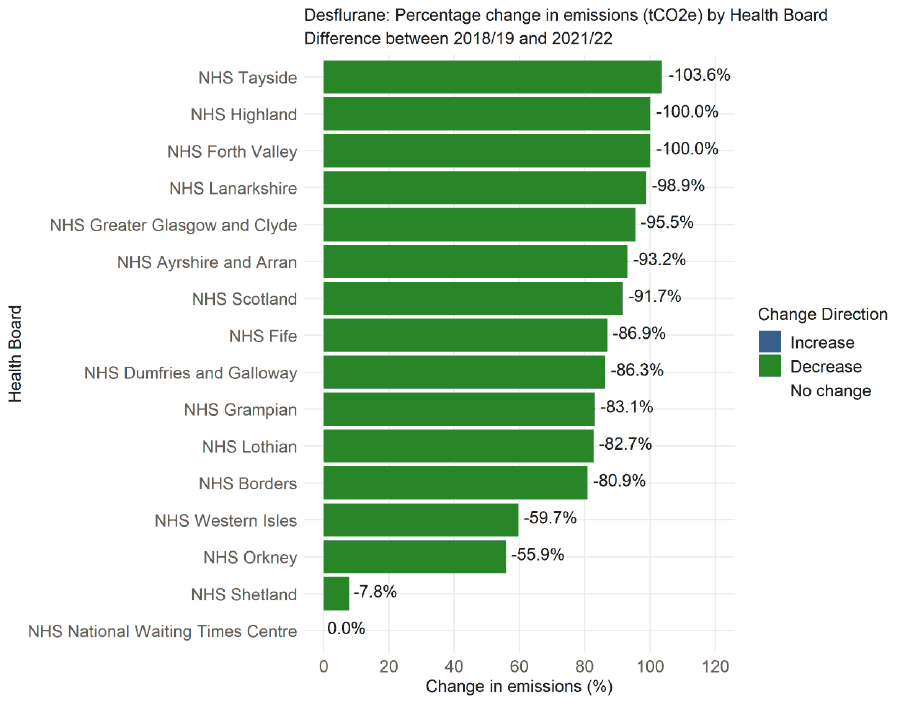 NHS National Waiting Times Centre shows a 0% reduction.">
NHS National Waiting Times Centre shows a 0% reduction.">
4.2 Nitrous Oxide
Nitrous oxide is used in general anaesthesia and for pain relief (in combination with oxygen, under the brand name Entonox, commonly known as “gas and air”). It is an important source of pain relief, and is particularly important for maternal health when a woman is in labour.
Nitrous oxide emissions are largely caused by leaks in piped medical gas systems. It is also used much less in modern anaesthetic practice than in the past and many piped systems are redundant.
There have been encouraging reductions in emissions from piped nitrous oxide over the period 2018/19 to 2021/22. However, there are variations in trends at Health Board level:
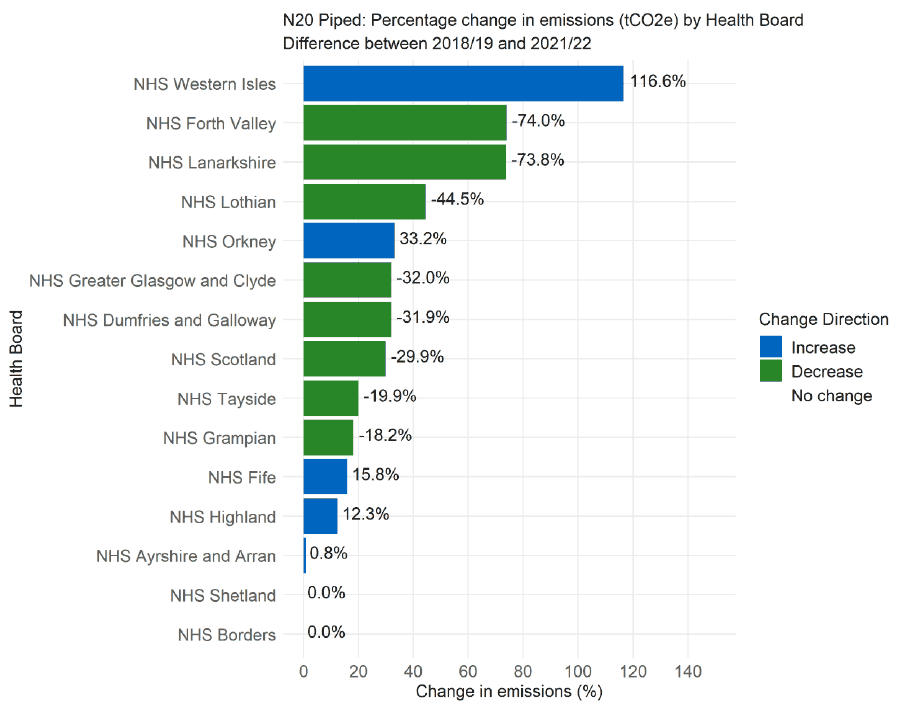
A national programme of work was established in 2021/22 with the aim of supporting further reduction in nitrous oxide emissions. The following documents have been issued to support Health Boards in reducing their emissions of nitrous oxide:
- Interim protocol for decommissioning of nitrous oxide manifolds (scot.nhs.uk)
- Nitrous Oxide mitigation implementation plan (scot.nhs.uk)
- Technical update: Anaesthetic nitrous oxide system loss mitigation and management (scot.nhs.uk)
Unlike nitrous oxide for general anaesthesia, Entonox continues to be commonly used for pain relief. NHS Scotland aims to ensure that Entonox is available for pain relief while also minimising the gas which escapes to the atmosphere.
4.3 Respiratory medicine
Greenhouse gases are used as a propellant in metered dose inhalers prescribed for the treatment of asthma and COPD. Most of the emissions from inhalers are from the use of reliever inhalers – Short Acting Beta Agonists (SABAs). By helping people to manage their condition more effectively, we can improve patient care and reduce emissions. There are also more environmentally friendly inhalers such as dry powder inhalers which can be used where clinically appropriate. Table 4 below sets out the emissions from this source in NHS Scotland over the last four years. Further data is set out in the Annex . Emissions from inhalers dispensed in secondary care are only included from 2021/22 onwards.
| Indicator | Emissions (tCO2e) | |||
|---|---|---|---|---|
| 2018/19 | 2019/20 | 2020/21 | 2021/22 | |
| Primary care - inhaler propellant emissions | 79,535 | 84,844 | 78,860 | 81,351 |
| Secondary care - inhaler propellant emissions | 2,162 | |||
| Total - inhaler propellant emissions | 79,535 | 84,844 | 78,860 | 83,513 |
Emissions from this source have remained constant at a national level over the last four years. This has not been a priority area for action by NHS Scotland until recently and so no decrease in emissions was anticipated. However, there is variation in the emissions at individual Health Board level although it is not known whether they are significant or due to normal variation in prescribing over time (see Figure 9 below). Further information is provided in the Annex.
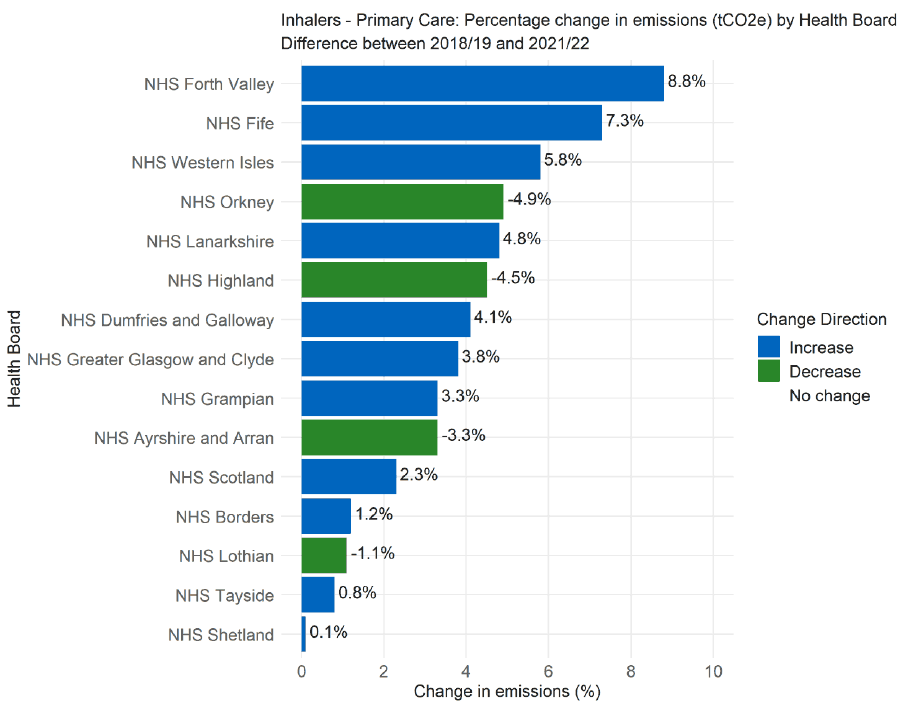
The National Respiratory Quality Prescribing Guidance was revised during 2022, written by the Scottish Government and NHS Scotland, supported by patients, patient organisations and a multidisciplinary team across primary and secondary care. This builds on the previous 2018 – 21 Strategy and continues to promote good person-centred care and incorporates environmental considerations of prescribing for respiratory conditions.
The guidance will be published in Summer 2023 for a full public consultation, aiming for final publication in the Autumn. Specific recommendations to encourage consideration of the environmental impacts when prescribing in respiratory medicine are included, for example, ensuring that local formularies contain information for prescribers on inhalers with a lower global warming potential. Experts by Experience (people with personal experience of suffering from respiratory conditions or caring for someone who has) formed part of the guidance development group, and were given the opportunity to raise any concerns with the guidance which were addressed. The guidance is person-centred, aiming for optimising respiratory care with an emphasis on prescribing the right inhalers for the individual to get better outcomes for them, minimising over-use of reliever inhalers and supporting individuals to use propellant-free options where clinically appropriate. There has also been engagement with stakeholders, for example, Asthma and Lung UK, Chest, Heart and Stoke Scotland, the Scottish Respiratory Advisory Committee, the Scottish Respiratory Pharmacy Special Interest Group and NHS Education for Scotland (Pharmacy and Nursing).
4.4 National Green Theatre’s Programme
The Centre for Sustainable Delivery, which is part of NHS Golden Jubilee, has been commissioned to deliver the National Green Theatres Programme (NGTP). The Programme aims to reduce the carbon footprint of theatres across NHS Scotland and enable more environmentally sustainable care, by:
- using the learning from the pilot work done by NHS Highland: assessing and packaging these into bundles of high impact actions.
- coordinating the implementation of these bundles of action across NHS Scotland.
- exploring other potential high impact actions and innovations.
- sharing learning on the wider applicability of these actions to other care settings.
Focusing on reducing the environmental impact of theatres provides a great opportunity to make a positive difference in moving towards net zero targets.
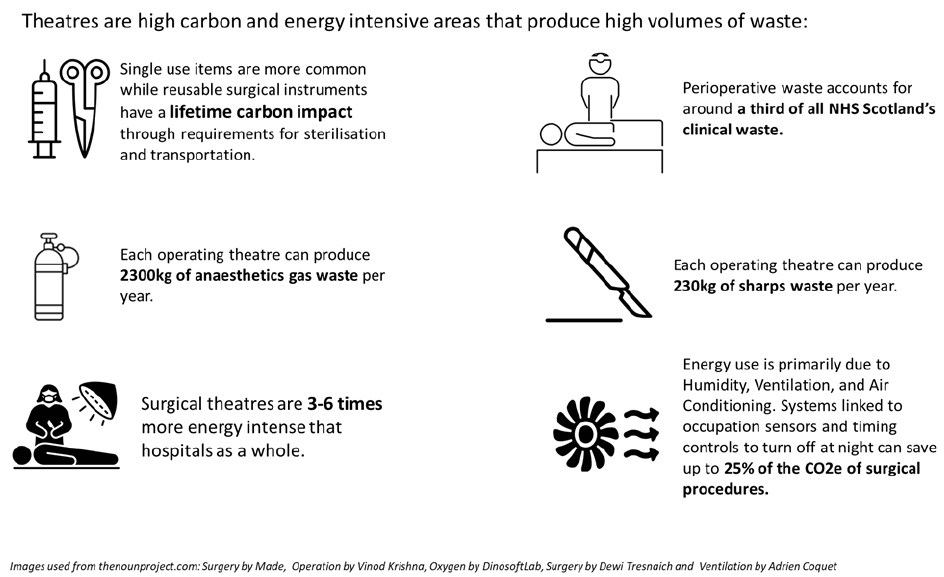
The NGTP is founded on the learning from NHS Highland’s Green Theatre Project (GTP). This project was a series of local initiatives which reduced greenhouse gas emissions, resource use and waste associated with surgery. The key actions are outlined below in Image 2.
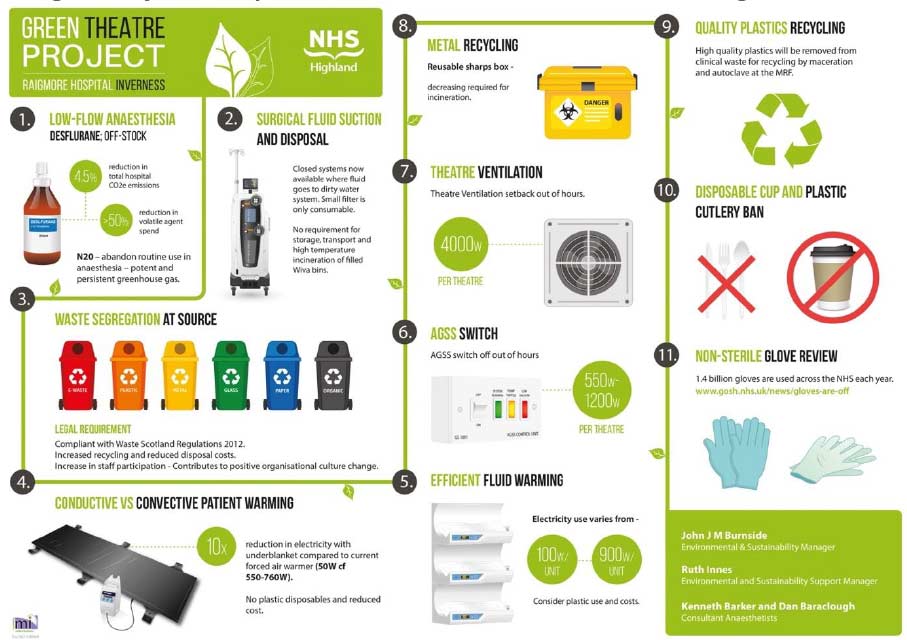
Dealing with liquid clinical waste
During normal theatre operation a significant quantity of liquid clinical waste (mainly body fluids) is created. Management of this waste has significant financial and environmental costs. The waste is collected in suction receptacles with the addition of a gelling agent to ensure it can be safely transported and is compliant. In some cases, receptacles are placed in additional plastic packaging. Depending on the Board arrangement and waste classification, the waste is treated or sent on for High Temperature Incineration.
The current system uses various single use consumables with high financial and environment cost. The waste is often heavy, which can cause issues in terms of moving and handling that can impact the health and safety of staff.
The NGTP has been reviewing options to improve the management of this waste stream. The review includes systems which allow waste to be collected, filtered and discharged through the sewage system. A discharge system was first piloted at NHS Highland, has since been adopted by a number of Health Boards and is considered to be a viable alternative to single use disposable suction receptacles, offering sustainability, health and safety benefits. The NGTP is currently developing a business case which will support Boards in adopting such systems.
4.5 Realistic Medicine
Delivering Value Based Health & Care: A Vision for Scotland was published on 14 December 2022. It sets out some of the challenges our health and care system is facing and how practising Realistic Medicine can help deliver a more sustainable system. This vision is closely aligned with the NHS Scotland Climate Emergency and Sustainability Strategy; one of its three strategic aims is sustainability and stewardship, which aims for more sustainable and appropriate resource utilisation. The vision sets out that a culture of stewardship must be established in Scotland, where resources are safeguarded and used responsibly to provide environmentally sustainable healthcare. A central theme of Realistic Medicine has been to engage health and care professionals to become the stewards of healthcare resources, given that it is their decisions that commit our precious healthcare resources.
Contact
Email: DHFCGVAdminSupport@gov.scot
There is a problem
Thanks for your feedback